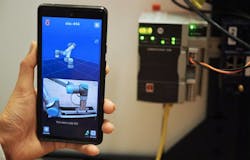Olis Robotics Adds PLC Tag Capabilities
Oct. 15, 2024
3 min read
Earlier this year at the Modex 2024 event, Automation World met with Olis Robotics, supplier of remote error recovery technology for industrial robots, to learn about their technology and how their system works with Kawasaki Robotics robots to enable users to reduce troubleshooting and downtime costs by up to 90%, restart production faster and gain remote access to expert support.
Olis Robotics has since added new capabilities that enables it to not just assess robot operations, but to monitor, diagnose and debug entire robot cells. According to the company, this new range of capabilities allows Olis to reach “from the PLC to the
fingertips of the robotic gripper, including conveyors and other hardware.”
Using Olis software, users can monitor and set alerts for pre-defined runtime parameters through the PLC, including I/Os, registers and custom tags. Typical applications for PLC tags include measuring overall equipment effectiveness (OEE), monitoring cycle times and fault detection.
Fredrik Ryden, CEO of Olis Robotics, said, “The PLC often contains important diagnostic data required to understand the causes of unplanned downtime. Olis’s new PLC capabilitiesenable real-time access to that data, effectively closing the loop on video-based diagnostics for industrial automation systems.”
The new PLC features are specific to Rockwell Automation’s Allen-Bradley PLCs, while robotic arms compatible with Olis’s technology include Universal Robots, Kawasaki Robotics and Fanuc. Ryden noted that additional brands of PLCs and robotic arms will be Olis compatible soon.
The work cell information feed provided by Olis can be accessed worldwide over 5G, allowing users to “zoom in and get a better picture of the issue,” said Ryden. “Users can also see the error log. The person who's responsible for this system would be immediately notified no matter where they are so they can go in and review the alert, get the synchronized log files and video and see the issue encountered in the cell via an instant replay of what happened to cause the error.”
Ryden noted that this new functionality can even be used to maintain and improve standards in production throughput. For example, in an application involving a robot inserting bolts into a part, users could create an alert that indicates when the feeder is running low on bolts. The PLC can then send Olis an alert informing the operator that it’s time to refill the feeder.
Olis expects this new functionality to be particularly helpful to system integrators to debug a system before shipping and remotely manage it.
“Diagnosing the cause of failure in modern automation cells is notoriously
difficult and requires considerable expertise. This is due to the complexity and variety of
components involved,” said Steve Solack, controls engineering manager at system integrator Mission Design & Automation. “With the most crucial diagnostic information often being found in PLC tags and robot data, being able to quickly access such data via Olis’s easy to use interface reduces the time and skill set required to understand the problem, making us more efficient and reducing downtime costs for our customers.”
Kilen Multop, IT director at system integrator Kaitech Automation, said the new Olis capabilities will help support Kaitech’s plans “to deploy a large number of robot cells
to a variety of customers in the coming years. To support this rapid growth, we need to ensure that robots are deployed quickly and without problems. We will also need to track cell performance for many years to come.”
About the Author
David Greenfield, editor in chief
Editor in Chief
David Greenfield joined Automation World in June 2011. Bringing a wealth of industry knowledge and media experience to his position, David’s contributions can be found in AW’s print and online editions and custom projects. Earlier in his career, David was Editorial Director of Design News at UBM Electronics, and prior to joining UBM, he was Editorial Director of Control Engineering at Reed Business Information, where he also worked on Manufacturing Business Technology as Publisher.
Sign up for our eNewsletters
Get the latest news and updates

Leaders relevant to this article:
